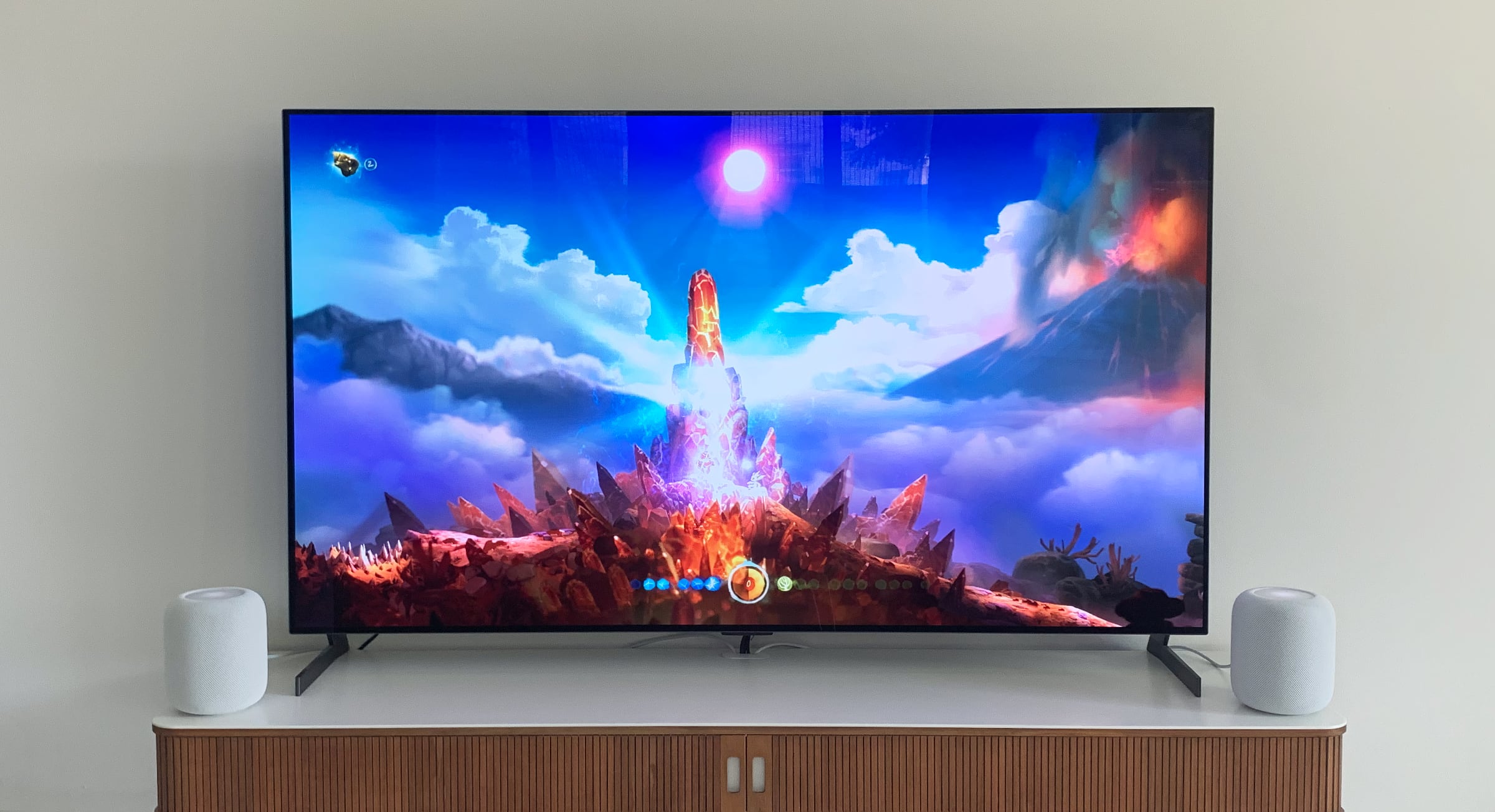Apple has launched HomePod (2nd Gen), which in addition to serving as a music speaker can function as a set of wireless TV speakers for your TV screen and all its HDMI sources including PlayStation, Xbox, and set-top boxes. This requires an Apple TV 4K (2nd or 3rd Gen) that can act as a sort of AV receiver due to HDMI eARC/ARC. Apple TV 4K (1st Gen) is also compatible with HomePod but cannot extract audio from the TV and its HDMI-connected devices.
FlatpanelsHD is testing a pair of HomePods (2nd Gen) with a focus on TV integration for movies, shows, games, and music.
Price and retailers:
Apple HomePod (2nd Gen) – specifications
| |
|---|
| Design | 2x cylindrical speakers |
| - color | white/black | | - dimensions (HxWxD) | 16.8 x 14.2 x 14.2 cm | | - weight | 2.3 kg | | - wall mounting | |
|
|
| Speakers | 360 audio |
| - Bass | 1x 4-inch | | - Tweeter | 5x horn-loaded, each with its own neodymium magnet | | - Total output | ? | | - Other | 5 microphones for real-time tuning, room calibration & bass correction | |
|
| Audio formats | Dolby |
| - Dolby Atmos | | | - Dolby TrueHD | | | - Dolby Digital Plus | | | - Dolby Digital | | | - DTS:X | | | - DTS-HD | | | - DTS | | | - LPCM | |
| - MPEG-H | | | - Hi-Res Audio | | | - 360 Reality Audio | | |
|
|
|
| HDMI in/out | |
| - HDMI input | | | - HDMI ARC / eARC | / | | - HDMI CEC | | | - passthrough 4K | | | - passthrough HDR10 | | | - passthrough Dolby Vision | | | - passthrough ALLM | | | - passthrough VRR | | | - passthrough QMS | | |
|
| Inputs | AirPlay 2 |
| Outputs | |
| WiFi | (WiFi 4) |
| Wireless audio protocols | Yes |
| - Chromecast | | | - AirPlay 2 | | | - Spotify Connect | | | - Bluetooth | | | - Other | Multiroom (AirPlay 2), Siri, Thread, UWB, built-in temperature/humidity sensor |
|
|
| In the box | Detachable power cable |
First impressions
Apple's HomePod (2nd Gen) shares both the size and form of the original HomePod, which was never released in most regions of the world due to the absence of localized Siri at the time. The speaker is available in two colors (white and dark gray) with a color-matching power cable, which, unlike the original HomePod, can be detached and replaced.
Everything else operates wirelessly, meaning there are no physical inputs or outputs on the HomePod. It is designed to receive audio content only wirelessly, either directly over the internet or from another Apple device via AirPlay such as an iPhone or Apple TV 4K box. Technically, Bluetooth is built in, but it is exclusively used for HomeKit control of connected smart devices – not for any type of audio.

HomePod's internal components. Photo: Apple
I have owned a pair of the original white HomePods since the launch five years ago, and over time in a household with small children a bit of dirt has accumulated on the white mesh. The touch-sensitive surface at the top often invites people to touch, so the speakers rarely remain undisturbed. The mesh has also become slightly discolored, perhaps due to exposure to sunlight. I have heard that you can gently clean the mesh, but I have not attempted.
Below, you can see how my 5-year-old HomePod compare to a new white HomePod (2nd Gen).
New (left), old (right)
However, even the new white HomePods can tend to look a bit dirty from certain angles during daylight, as the electronics can be spotted through the mesh, so consider if the white variant might be too delicate for your home. That being said, the material and design are elegant and fit well in many living spaces. They neither feel nor look cheap, which is often the case with soundbars.
The touch-sensitive surface at the top lights up white when the speaker is active. There are touch-sensitive areas for adjusting the volume. Tapping in the center starts or stops music/video playback. Dancing colors on the touch surface indicate that Siri is listening.
If you have never seen a HomePod in person, I believe your initial impression will be that the speaker is considerably smaller than expected – that was certainly my first impression. However, inside, there is a 4-inch woofer and five tweeters. There are also five microphones for automatic real-time audio tuning and room calibration, as well as bass correction. The power supply is built-in.
In terms of design, the HomePod stands out significantly from a soundbar and in my experience they look most natural when the TV is wall-mounted above them. Two HomePods should also be placed at a reasonable distance from each other (at least 1.2 meters, according to Apple) to achieve proper stereo perspective and a virtualized center channel – more on that later.
Setup
The setup process is straightforward but requires an iPhone/iPad (not possible with Android, Windows, macOS) to be in proximity to the HomePod, after which you follow a few steps on the iPhone display. You must log in with your Apple ID and HomePod prompts you to say a few things so that it can get to know your voice.
HomePod can distinguish between voices, which is useful for personal music preferences, but this requires that you have set up the Apple IDs of household members for Family Sharing.
Pairing with Apple TV 4K is also straightforward, but you need to ensure that Apple TV 4K and HomePod are set to the same room in the Home app on your iPhone/iPad/Mac before proceeding. Also, be aware that the degree of HomePod integration depends on the generation of your Apple TV. Here is how it works:
HomePod pairing to Apple TV
| Pairing | eARC/ARC for TV audio extraction | Dolby Atmos | Movie & game audio |
|---|
| Apple TV HD |
(only temporarily) | | |
(video only) |
| Apple TV 4K (1st Gen) | | | |
|
| Apple TV 4K (2nd Gen) | | | | |
| Apple TV 4K (3rd Gen) | | | | |
FlatpanelsHD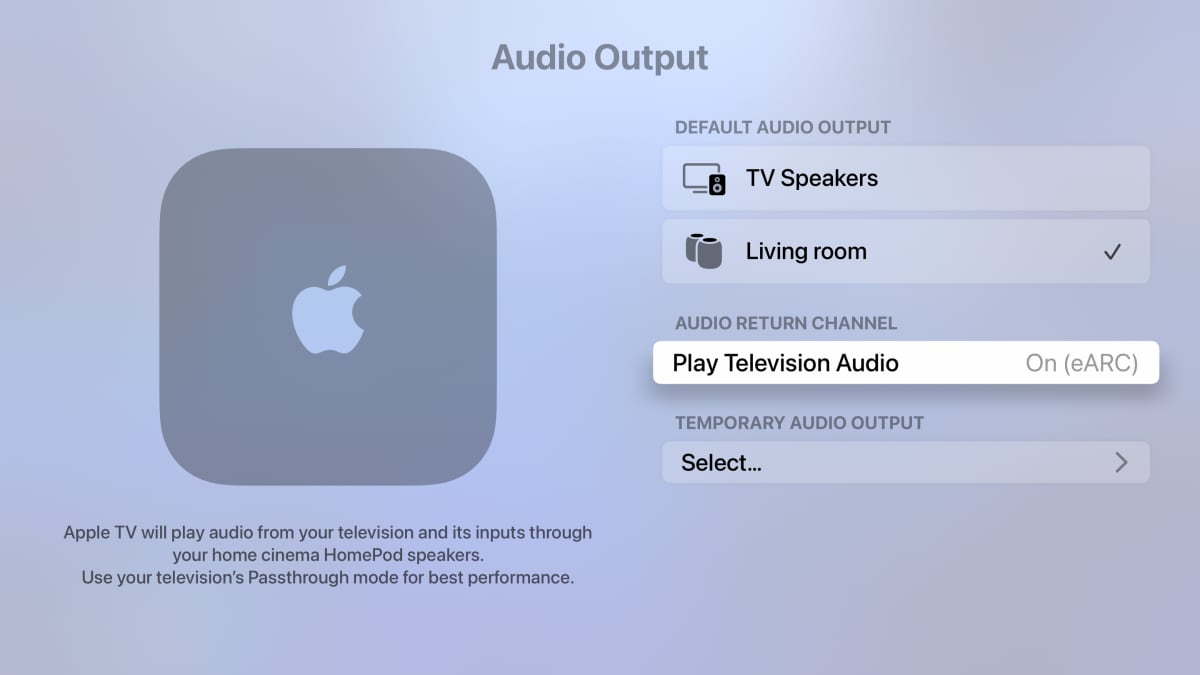
Activate ARC/eARC on Apple TV 4K to play all audio from the TV and its HDMI devices on HomePod. Photo: FlatpanelsHD
Now you are all set for a pair of HomePods to take over as your TV speakers, with Apple TV 4K acting as a sort of AV receiver. Every time you turn on the TV, the sound will automatically come from the HomePods. Audio will not revert to the TV's speakers unless you disable HDMI ARC/eARC on the TV. This is possible because Apple TV 4K is always in standby and never completely shuts off. In other words, you should not turn it off at the power source.
A side note: Currently, it is not possible to route audio from the TV's eARC to Apple's headphones (AirPods) – only HomePods.
It is worth mentioning that, like the HomePod mini but unlike the original HomePod, HomePod (2nd Gen) has built-in sensors for temperature and humidity that can be used in automations in the connected home. HomePod (2nd Gen) can serve as a hub for these automations, acting as both a Thread Border Router and a control unit for HomeKit. It also has a built-in UWB (Ultra Wideband) chip to detect when an iPhone with UWB approaches in order to take over music playback. However, its Wi-Fi is limited to the n-standard (Wi-Fi 4) – an unusual limitation not found in the earlier HomePods.
Measurements
Apple HomePod (2nd Gen) is powered by Apple's own S7 chip, which was originally developed for Apple Watch. The chip is highly energy-efficient, so the primary power consumption can be attributed to the HomePod's speaker units.
| Power consumption | HomePod (2nd Gen) |
|---|
| Normal TV audio | 6-9W |
| Movie at high volume | 10-38W |
| Waiting position | 5.9W |
| Stand-by | 1.1W |
Wireless TV audio: Stability & latency
When it comes to wireless TV speakers, it is of course crucial to have a stable connection and minimal audio delay (latency). I will address this point before moving on to functionality and sound quality.
Sonos has built a reputation for handling the task of wireless TV audio well. The key difference between Sonos and HomePod is that Sonos requires a soundbar with HDMI to act as the master unit, while Apple has essentially integrated the same wireless functionality directly into the Apple TV 4K. This eliminates the need for an HDMI cable to the speaker but adds an extra power cable for the second HomePod.
My original HomePods, which are nearly 5 years old, have been rock-solid when paired with Apple TV 4K during the 2-3 years in which they have been actively used for TV audio. I have not experienced a single connection dropout, which has surprised me. The exact wireless connection method between Apple TV and HomePod has not been officially confirmed, but it does require a Wi-Fi network in your home – which can be a source of problems if your Wi-Fi is not stable. To me it seems that a dedicated Wi-Fi Direct connection is established between Apple TV 4K and HomePod, which requires specific hardware in both devices. This would explain why Apple TV HD is not supported.
As for HomePod (2nd Gen), it is difficult to say with certainty, as we have only been testing them for a few months. However, so far, it is pretty much the same story. Once after setup, I had to restart the Apple TV 4K because the audio started to crackle. However, this has not happened since in my setup. For the test, I attempted to simulate an environment with very poor Wi-Fi coverage by moving all devices around, which revealed that even in poor Wi-Fi coverage, audio to the HomePod remains relatively stable as long as the Apple TV is connected via a cable. However, the sound can start crackling as the connection deteriorates, and it appears that it in very poor WiFi environments degrades audio quality to prevent audio dropouts.
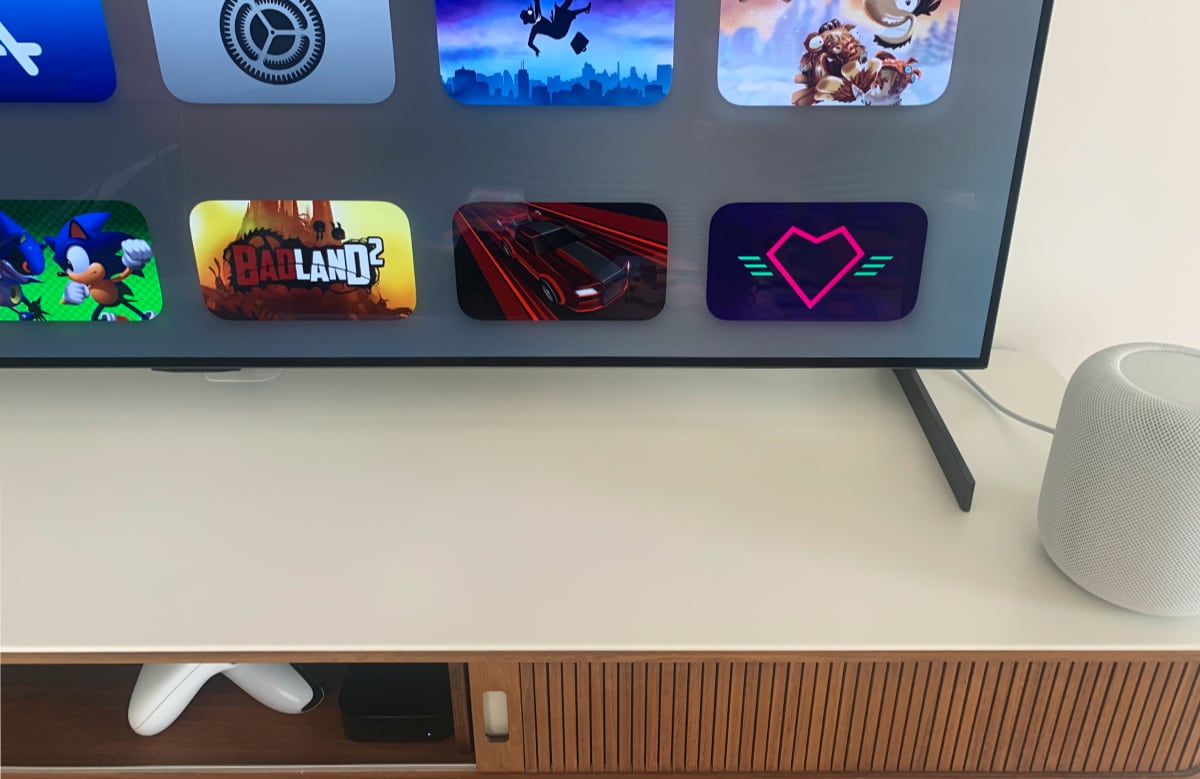
Apple TV 4K (bottom) has been inside the furniture with the lamellas closed for the whole duration of the test
Audio delay with TV sound on HomePod is practically non-existent. This applies even to game audio, which is quite an achievement as game audio is generated in real-time (so there no option to preload or buffer game audio). Whether it is a racing game or a music game, the connection was rock-solid for me, and the latency is so low that I have never noticed any issues during gameplay. This is possible because Apple TV 4K operates in a PCM (Pulse Code Modulation) environment, as opposed to bitstream, which means all audio flows uncompressed. It is important to note that this does not necessarily mean your audio source (e.g., streaming) is in uncompressed audio quality; it just means that Apple TV 4K unpacks and decodes all audio before sending it.
Synchronizing HomePod audio with the TV's picture, on the other hand, can be a task you need to handle during setup. To understand the situation, we tested the HomePod (2nd Gen) with TVs from LG, Samsung, Sony, and TCL. We did not encounter any issues with HDMI eARC compatibility when using newer TVs from these four brands and HomePod via Apple TV 4K. However, with TCL, enabling eARC required a manual procedure. In the other cases, the TV automatically switched to eARC when the feature was activated on Apple TV 4K.
There can be many reasons for AV sync issues, but in general it often comes down to a lack of communication between devices; the right hand does not know what the left hand is doing. If you are using an external player for video playback, the TV and sound system might not always be aware of what is happening on the player and vice versa.
Here are 3 things you should do during setup, in this order:
- TV screen: Turn off motion-smoothing (TruMotion, MotionFlow, Motion Plus, etc.). Motion smoothing inserts fake frames into the video stream, which typically requires a delay of over 100 milliseconds or more. The exact delay in milliseconds can vary depending on the content's format, leading to occasional audio sync issues.
- Apple TV 4K: Because audio/video delay can occur at different points in the chain, Apple TV 4K includes a built-in feature to correct AV sync. It is called 'Wireless Audio Sync' under Settings -> Video and Audio. This feature uses the TV's built-in speakers (not HomePod's) to play test tones, which are picked up by a compatible iPhone nearby. In my experience, this calibration eliminates any audio delay. Please note that you should run the Wireless Audio Sync with Apple TV 4K set to 60Hz video output first, then 50Hz, and finally 24Hz if you are using Apple TV 4K's 'match frame rate' feature. This is because TV screens can have different levels of delay depending on the refresh rate.
- HDMI-connected devices: For players/consoles connected to your TV screen via HDMI, make sure to set audio output to the uncompressed (L)PCM format rather than compressed bitstream. This ensures that video and audio unpacking occur synchronously on the player rather than at different points in the AV chain.
The Wireless Audio Sync feature could indeed be more elegant (synchronizing 24Hz, 50Hz, and 60Hz in one go), and Apple could make users more aware of the calibration function, perhaps even making it a mandatory step in the setup process. Alternatively, they could just their own TV!
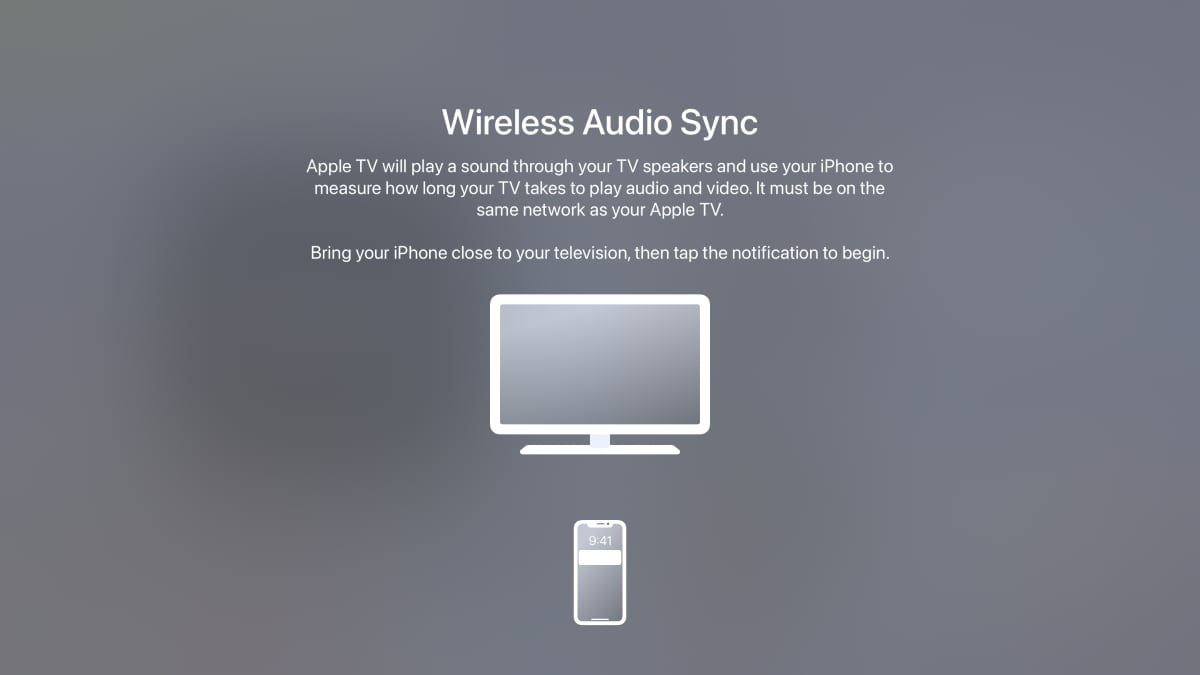
Remember to run 'Wireless Audio Sync' in both 60Hz, 50Hz and 24Hz video-output. Photo: FlatpanelsHD
Listening test: Music
We are testing the HomePod with a focus on TV audio, but HomePod is of course primarily designed as a music speaker. Apple's approach where it has flipped the priorities (music first, then TV audio) makes so much more sense that it surprises me that other electronics giants have not done it already.
Classic HiFi brands have taken a similar approach, but they often pay less attention to the TV aspect. Luxury brands such as Bang & Olufsen have a similar approach but in a completely different price range. On the other hand, LG, Sony (except for HT-A9), Samsung, Philips, Panasonic, TCL and others seem too focused on launching soundbars, and nobody can disagree that the soundbar form factor is not ideal for delivering high-quality music.
That Apple – and to some extent Sonos – has created a music speaker that can act as a TV speaker is also a result of technological solutions and practicality. It is not practical to run an HDMI cable from the TV to the left front speaker and then connect a cable to the right front speaker. Wireless audio is a necessity, along with a robust wireless platform. I have been saying for years that the transition to wireless audio will open up the flexibility for far more consumers to install surround sound or similar setups in their living rooms. Traditional HiFi has never appealed to the typical consumer, which is why surround sound still has such limited adoption after decades.
One HomePod performs well for music in a semi-large living space, but two in a stereo pair significantly improves the sound quality while providing a genuine stereo perspective. In my testing they handle all music genres well, including electronic and rock, and perhaps a little surprisingly these small speakers deliver impressive sound. This is the first impression expressed by everyone I have demonstrated them to. Soundbars in the same or significantly higher price range simply cannot match the sound quality delivered by a pair of HomePods when it comes to music.
One of the "secrets" is that HomePods automatically learn the room's layout using built-in microphones and automatic room calibration. If you move a HomePod, a sensor registers the movement and the room calibration takes place anew when it becomes stationary again. This is a completely different way of working with room acoustics compared to normal speakers.
I have mentioned this before in relation to the original HomePods and how it makes a pair of HomePods better music players than my B&O BeoLab 9 speakers, which cost many times more, in a room with large windows and stone floors. It is surprising not only because BeoLab 9 costs so much more but mostly because the automatic room calibration is so decisive in my experience. Of course, they do not match BeoLab 9 in terms of bass or power, but the balance in sound and the absence of unintended echo/sound reflection, thanks to the HomePods' awareness of the room they are in, makes me prefer HomePods for music in my current living room. I have taken them outside on the terrace a few times too, where I am also impressed by how well they adapt automatically.
Combined with lossless music quality and Dolby Atmos (from Apple Music), the performance in this price range is top-notch.

Music in Dolby Atmos can be played directly through HomePod or using Apple TV 4K. Photo: FlatpanelsHD
However, there is a significant limitation to consider, which is that only Apple Music is fully integrated with HomePod. Spotify and other services require an iPhone/iPad and the use of AirPlay, which can be a drawback. HomePods are undoubtedly most suitable for Apple Music users, where some of the best music tracks in Dolby Atmos can sound fantastic. On the other hand, some Dolby Atmos tracks can come across as gimmicky. When Atmos music works best on HomePod, it is as if the audio has an extra layer of ambiance; as if some sounds that shape a bassline or instrumental rhythm originate from somewhere else than the rest of the sounds; as if the sound field surrounds you a bit more. This is something sound designers appear to be specifically attentive to when using object-based audio like Dolby Atmos, and something they have started to leverage (read: First listen: Sony's ecosystem of 360 Spatial Sound products).
When using HomePod in the living room for both music and TV audio, there are some additional functional considerations. It has taken numerous tvOS updates (both Apple TV 4K and HomePod run tvOS) to reach this point and there have been some odd glitches along the way (especially with the original HomePod). But now, it works reasonably well. For instance, if you ask HomePod to play music, the TV remains off. If you ask Siri to open Netflix, the TV screen turns on automatically. It has not always worked like that.
Also read: AirPlay 2 speakers may soon function as default Apple TV speakers
The only times when I occasionally still experience the TV screen turning on during music playback are in inexplicable scenarios when playing from an iPhone via AirPlay. It seems like Apple TV thinks a music video is coming, even when it is not the case. This happens very rarely, but it is a pesky issue that Apple should identify. Another annoyance is that Apple TV sometimes forgets to pause the video when I pick up the game controller to turn on the Xbox/PlayStation and the TV switches to the console's HDMI. This results in two audio tracks playing simultaneously on the HomePod. It is not a big deal, as you can simply press pause on Apple's remote or ask Siri to do it, but it should work as intended every time.
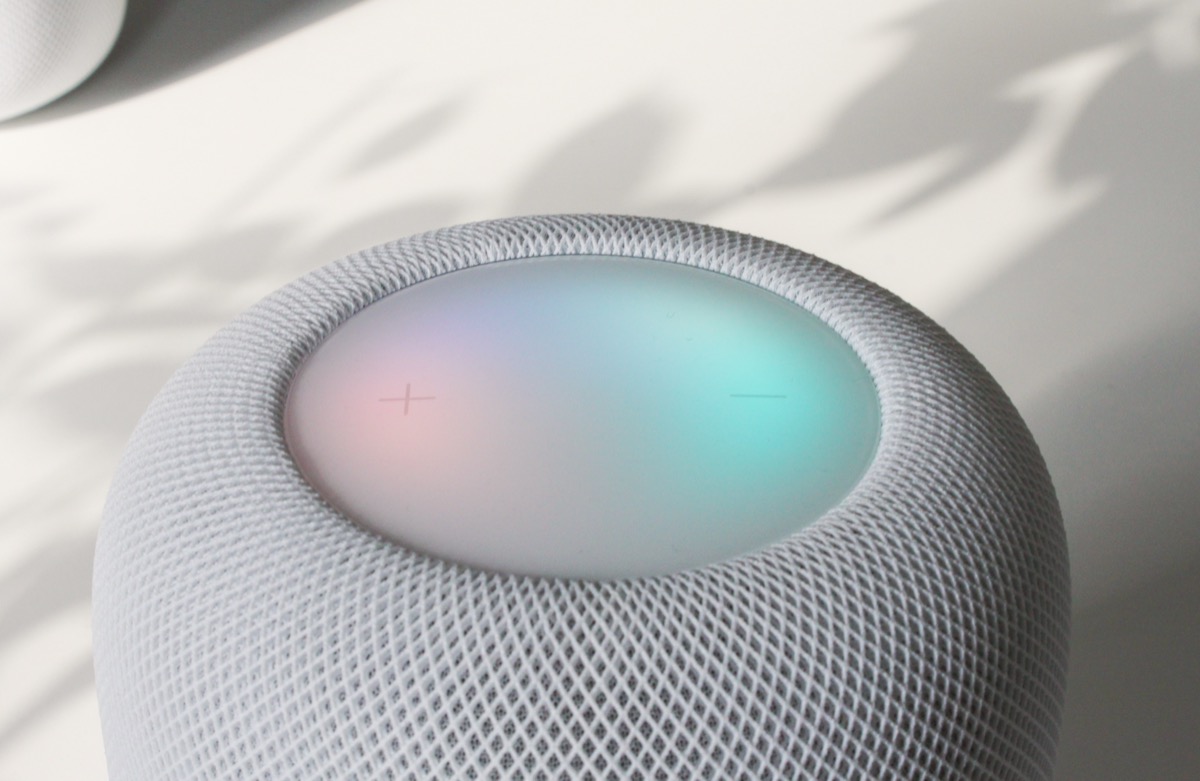
Colorful lights in the touchpad on top of HomePod means that Siri is listening
Other than that, HomePod has become a very elegant multi-speaker system that can stand alone or work in conjunction with other HomePods in a multi-room setup. You can expand your music to multiple rooms using your iPhone or, a bit more cumbersome, Siri. You can also command HomePod to perform tasks like adjusting the home's temperature (requires a HomeKit-compatible thermostat) without interrupting your movie or music playback. You can pair a maximum of two HomePods as a stereo pair, but more can play music together in harmony in the living room if you select them from your iPhone.
Choosing and controlling music via Siri can be both enjoyable and a source of great frustration when she does not recognize the title or artist requested. I find Siri in my local language (Danish) to be less than ideal because the mix of English and Danish does not work very well. But even in English, there are song titles or artists that Siri simply does not grasp (including titles in other languages), and more than once I have received an error message that she could not connect to Apple Music, only for it to work two seconds later. It seems like a connection issue to the Siri server. It is baffling to me that Siri is still so unreliable after so many years. Limited functionality can be accepted, but stability and reliability should be have been ironed after so many years. "Hey Siri" works most of the time, but there are still situations where she does not respond despite no noise in the room. This happens particularly when my wife and daughters speak to her.
Listening test: Movies
Using the integration with Apple TV 4K, a pair of HomePods becomes a genuine alternative to a soundbar. Personally, I find two small, round speakers to be a more elegant solution but this is of course a matter of taste. A soundbar placed next to the TV can quickly turn into a Frankenstein creation of various parts that do not have dimensions, materials, color, or anything else in common. I currently have my LG GX OLED TV (the one that can hang flush against the wall) on tabletop feet so it is not ideal to have HomePods standing on each side. However, I have seen HomePods placed on low furniture under a wall-mounted TV, which looks very clean.
As mentioned, I've owned a pair of the original HomePod since 2018, so initially I'd like to emphasize that the sound quality in the first and second generations is almost the same. There are slight differences in bass, midrange, and tuning, but not enough for me to point out one as a clear winner. If I were forced to choose one, I would say that the 2nd Gen is slightly more balanced in sound, but it requires sitting down and listening to both to notice the difference. The following test applies generally to the original HomePod as well, if you can still find them, maybe used. They function in the same way, and the same criticisms apply.
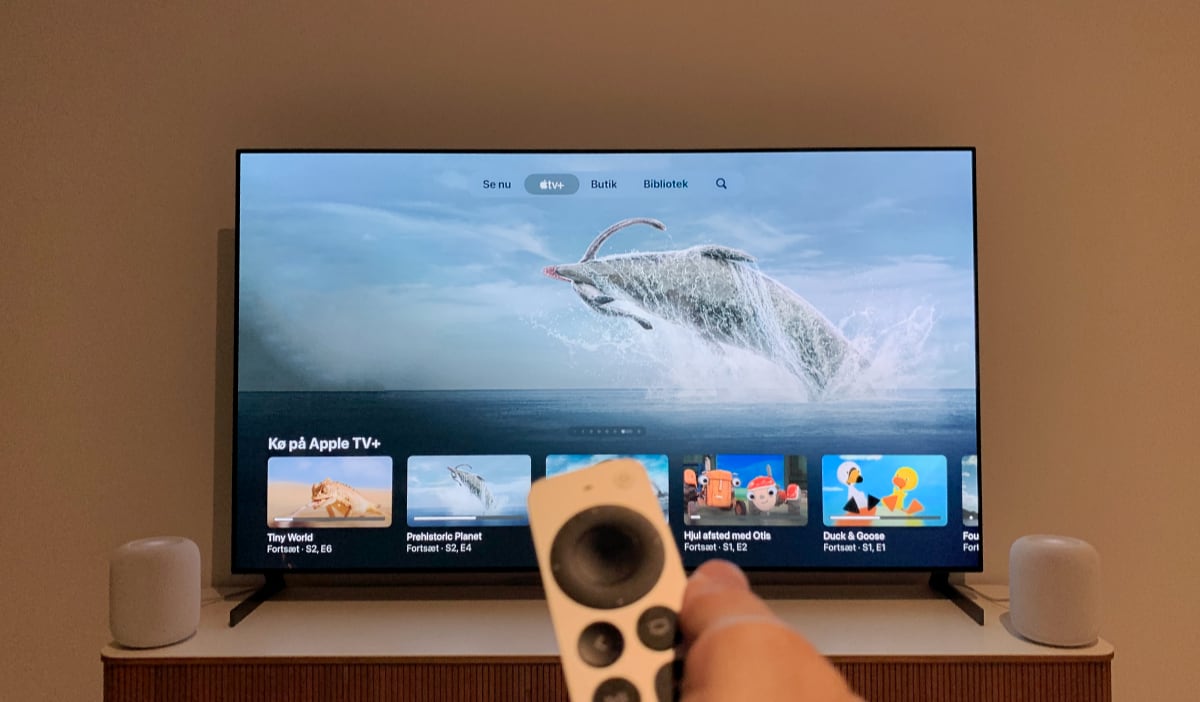
Apple HomePod (2nd Gen) paired to an LG GX OLED TV. Photo: FlatpanelsHD
As TV speakers, you need two HomePods. You can pair just one, but there are several reasons why it's not a good idea. First and foremost, TV audio requires a stereo perspective, and that's what a pair of HomePods provide. Two units working together can remarkably also simulate a center speaker where the TV screen is. In practice, it's primarily voices that come out of the virtual "center speaker," and the better your audio source, the better it works. This is one of the reasons why Dolby Atmos is advantageous also for stereo; because voices are stored as separate audio objects in the source, the device can direct these audio objects without the need to analyze audio frequencies and attempt to extract certain parts from a pre-mixed stereo or surround channel track – which is audio technology based on analog principles that should have been phased out long ago.
The "center speaker" created by two HomePods is the best phantom speaker I've heard from a pair of right/left front speakers. In practice, this means you get a stereo perspective that's broader than what a soundbar can provide, all while retaining the center channel of a soundbar. And on top of that, you get significantly better audio quality compared to most soundbars.
A pair of HomePods can also simulate some degree of side audio with a Dolby Atmos soundtrack. In the beginning, I often found myself looking to the side because the audio effect genuinely sounded like it was coming from our window. However, this effect greatly depends on the layout of your room. An entirely square room is ideal, but in my living room, one side wall is close, and the other is far away, so the effect is only noticeable on one side. How it sounds in your room can only be determined through testing. When it works, though, a pair of HomePods manages to create a relatively full and detailed audio perspective within the viewer's active field of vision toward the TV. There are excellent scenes for showcasing Atmos capabilities in movies like Gravity, The Matrix Revolutions, Soul, and Fantastic Beasts and some of them sound quite good on HomePods despite the obvious physical limitations.
At times, you might even sense a bit of rear audio effect, but it's rare and only at specific audio frequencies. This is where the party ends in terms of surround sound and Dolby Atmos. HomePods are designed as music speakers and excel impressively at utilizing the room's structure to provide a rich and immersive music perspective. However, TV audio is inherently more directionally oriented, and here they fall short on multiple fronts.
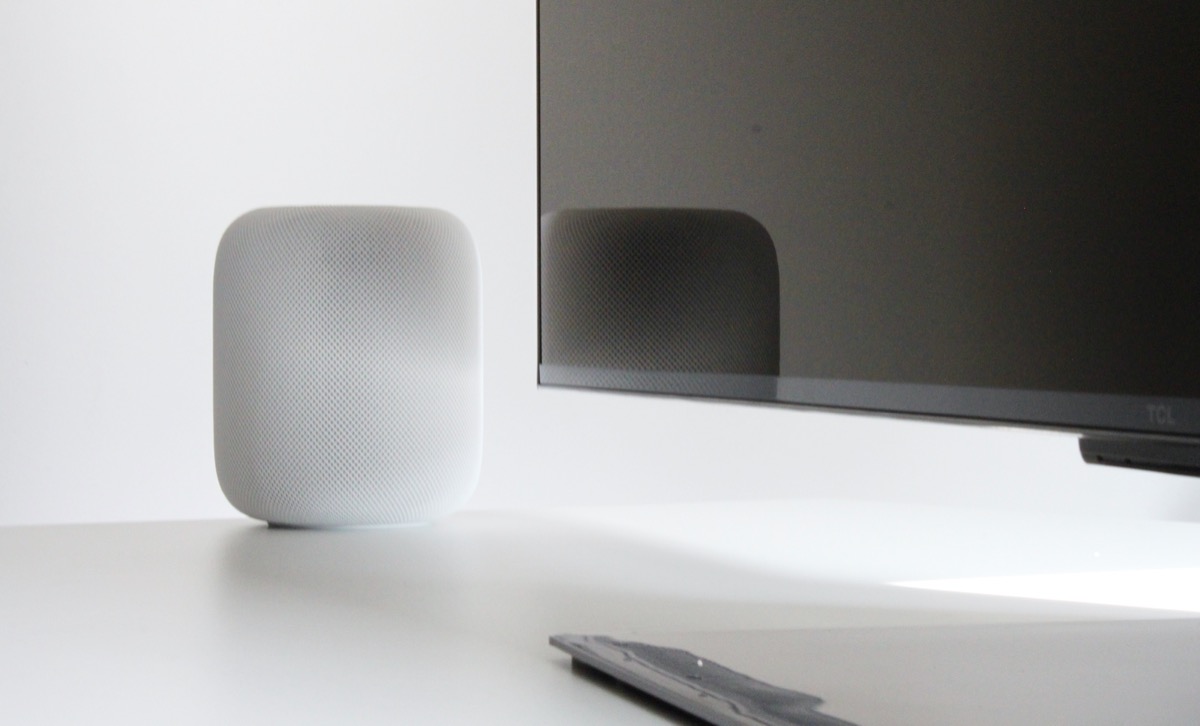
Apple HomePod (2nd Gen) paired to the TCL C845. Photo: FlatpanelsHD
The entire sound space behind the viewer is missing, as there is no option to add wireless rear units. This is something we often comment on in soundbar reviews; that they suffer from the same limitation but increasingly soundbars offer the ability to wirelessly connect rear speakers, which is the expansion we most frequently recommend. Perhaps a software update can make rear speakers possible with HomePod, perhaps not, or perhaps Apple has other plans. But as of now, surround sound options are absent.
The second most important (missing) expansion option concerns bass because even though a pair of HomePods have surprisingly deep bass, they don't reach the depths where subwoofers operate. They don't deliver thunderous bass, so for a movie night, a pair of HomePods won't make your room rumble, and they won't deliver adequate power and punch for explosions.
The third missing feature is overhead sound in conjunction with Dolby Atmos. HomePods manage to deliver a good width perspective but any height perspective. This isn't so surprising since they lack up-firing units, but the structure of a HomePod doesn't inherently prevent it, so the likely reason is that just that they were primarily designed as music speakers. There are rumors that Apple is developing a version of HomePod with a focus on TV sound, so it will be interesting to see what comes of that. Apple's sound simulation and automatic room correction are already impressive within the hardware constraints.
The balance of sound is good, but again, your room's structure will play a role. A pair of HomePods use built-in microphones to create a profile of your room and adjust the sound accordingly. This happens in real-time based on the type of audio input and the placement of the two HomePods, enabled by the relatively powerful processor built-in. It's a couple of levels above what competitors, including Sonos, typically do.
As mentioned, the bass is surprisingly good and well-controlled. It doesn't reach the very lowest frequencies, but it does not try to either, avoiding booming or overcompensation. The mid-tones are clear and defined, and the same applies to the treble, so everything from instruments to voices to general sound effects are clear and don't get lost in the audio landscape. In fact, I find the separation so good that I hear elements in both songs and movies that I haven't noticed when testing other relatively expensive soundbars – I've become quite familiar with the test material. The treble is well-balanced and pleasant without ever becoming shrill. I actually never feel that the speakers are trying in any way to compensate, causing irritation due to their limitations. There's just a lot of great sound coming out of these two small boxes, which know their own limits.
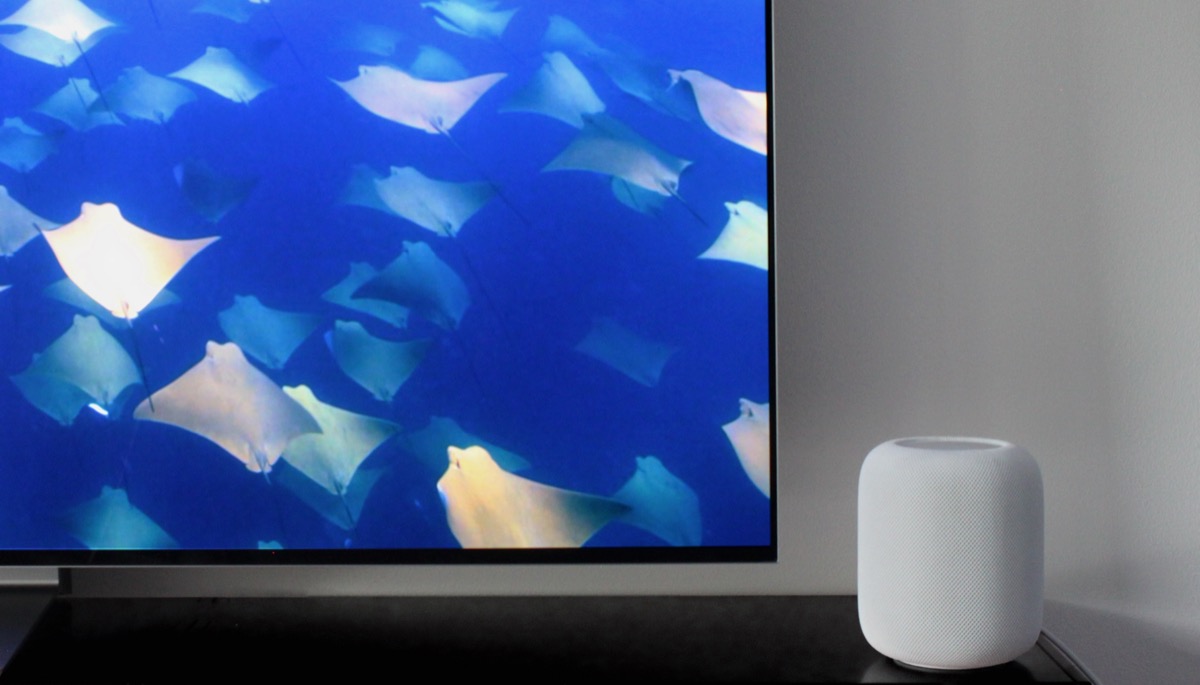
Apple HomePod (2nd Gen) paired to an LG G3 OLED TV. Photo: FlatpanelsHD
They are certainly not home cinema speakers, but in everyday use a pair of HomePods performs exceptionally well. Clear voices, a delightful balance in the sound (even at low volume) that doesn't require constant volume adjustments, and attention to detail make them a good choice living room TV speakers.
So, are a pair of HomePods an upgrade from built-in TV speakers? Without a doubt, they are a massive upgrade in every conceivable way compared to 99% of built-in TV speakers. Are they an alternative to a soundbar? Yes, and more than just an alternative. I've had the opportunity to compare them with Sonos. Compared to the Sonos Beam, I believe that HomePods outperform it significantly in terms of sound balance, bass, voice clarity, stereo perspective, surround simulation, and especially music. In fact, I would go so far as to say that HomePods can challenge the Sonos Arc in terms of TV sound in some scenarios (better width perspective but worse height perspective), while outclassing Sonos Arc in music quality. If you add rear speakers to the setup, the Sonos Arc takes the lead in TV sound, and if you also include a subwoofer, Sonos pulls further ahead.
I don't own a projector, but I'd like to make a point anyway. In principle, I believe that in a basement with a projector, you should invest in a "proper" surround sound system, if you have the space. However, if for some reason you prefer something more discreet, HomePods can address some of the connectivity issues often encountered with cable routing. Here, the Apple TV 4K can wirelessly transmit audio to the HomePods, eliminating the need for audio output from the projector or a receiver as a central hub as well as the need for any HDMI splitters. If you want to include a UHD Blu-ray player in the equation and your projector has ARC/eARC, you can connect the Apple TV 4K to the ARC port and achieve the same result – wirelessly sending the Blu-ray audio track from Apple TV 4K to the HomePods. This provides a degree of flexibility.
Listening test: Games
Sonos works with game audio because the soundbar connected via HDMI acts as the central unit for handling TV audio, after which the soundbar wirelessly beam audio to additional surround speakers. However, other wireless TV audio platforms that eliminate the HDMI-connected soundbar typically do not work with game audio. This includes devices such as Roku and FireTV, which both have wireless audio systems resembling Apple's integration between Apple TV 4K and HomePod. This limitation often goes unnoticed with Roku and FireTV because they don't really offer advanced games (due to hardware limitations) but only streamable games where audio behaves like a regular video stream, just like a video stream from Netflix.
Apple TV allows you to install games, and there is a growing pool of good – and not so good – games available, including several titles you might be familiar with from PlayStation and Xbox. Therefore, a solution with two HomePods wouldn't be complete if game audio didn't work. Fortunately, it does. Apple introduced wireless game audio with tvOS 14.2 in 2020.
Also read: Apple TV: Best games on Apple Arcade & App Store
Games from the app store and Apple Arcade generally feature stereo audio only. Apple hasn't prioritized Dolby Atmos or HDR for games yet. Stereo audio works well with a pair of HomePods, providing rich and clear game audio, which is much improved compared built-in TV speakers.
A more significant improvement in audio quality can be experienced with games from PlayStation and Xbox. PlayStation can transmit up to Dolby Atmos to HomePods via Apple TV 4K but Xbox is for some reason limited to 7.1 PCM audio with HomePods, despite supporting Dolby Atmos for soundbars and receivers – I'm not sure what the issue is. It's crucial to set your PlayStation or Xbox to output audio in PCM rather than bitstream, as bitstream can introduce very significant audio latency due to the console's re-encoding of all audio into a compressed bitstream. This requires your TV to have HDMI eARC rather than ARC; otherwise, you'll be limited to 2.0 (stereo) PCM. And eARC must be properly configured in your TV, too.
Nonetheless, playing a console game with a great audio track on a pair of HomePods is a pleasure. In a game like Ori and the Will of the Wisps, which not only showcases HDR beautifully but also boasts a fantastic audio track, the sound can be almost enchanting at times. Most of the credit goes to the game itself, but the HomePod manages to reproduce it in a detailed, powerful, and spacious manner. However, we still miss rear speakers and height perspective.
At some point, one would expect Apple to enable Dolby Atmos or its own spatial audio system in games on Apple TV 4K. HomePods are prepared for that possibility.
Controlling audio volume

You can also control volume with Remote for iPhone
Conclusion
A pair of Apple HomePods (2nd Gen) can be paired with an Apple TV 4K, enabling support for 5.1, 7.1, and Dolby Atmos audio. They can also be connected to a TV's HDMI ARC/eARC to pull audio from your TV, PlayStation, Xbox, and other devices. These two features make them a viable alternative to a soundbar, and in my opinion, a more aesthetically pleasing solution as long as the TV is wall-mounted.
A set of HomePods costs approximately $550-600, which makes them more expensive than the Sonos Beam, which they outperform, and cheaper than the Sonos Arc, which they surpass in certain aspects, particularly in terms of music. However, they lack the option to add additional speakers to the system, a feature possible with Sonos and other soundbars. This is what Apple needs to address to push the HomePod further in 'home theater' territory, primarily by offering the ability to add rear surround speakers.
A set of HomePods is a good choice as living room TV speakers for a mix of TV programs, movies, series and games, in my opinion. They are surprisingly powerful for their size, and their functionality is excellent (except for Siri), as long as you are in the Apple ecosystem. The flexible volume controls have also proven to be surprisingly useful, while Matter/Thread support, though promising, remains a bit enigmatic.
If you also intend to use HomePods as music speakers in your living room, the decision practically makes itself compared to a soundbar in the same or even a higher price range. Few soundbars can match a pair of HomePods in terms of sound quality, especially when it comes to music. It starts with classic stereo music across all genres, but when you add lossless (uncompressed) music, Dolby Atmos music, and, most importantly, HomePod's automatic room correction, the majority of soundbars simply can't compete. This even places HomePods in contention with more expensive speakers.
What the Apple HomePod lacks as TV speakers is, first and foremost, the option to expand the system with additional wireless speakers. Ideally, I want a more potent version – HomePod TV? – optimized for surround sound and Dolby Atmos, just like how the HomePod (2nd Gen) is designed primarily for music playback. Such TV-optimized HomePods should feature up-firing units, too. This combination would significantly enhance the experience, and I'm personally eager to see what comes of the rumor of a combined Apple TV and HomePod.
Price and retailers:
Good wireless TV speakers + virtual center
Great for music
Neutral & balanced sound
Automatic room calibration
Flexible volume control
Requires Apple TV 4K
No up-firing units
No options for surround expansion
Nearest competitors














